
Objective:
At a first glance, imported Asiatic and genuine Mediterranean pine nuts seem to be similar in size, colour and aspect. Cheaper Chinese chestnuts can also be confused with European chestnuts, when botanic species and origin are not declared on the label, despite this information being mandatory by UNECE marketing standards (2013).
However, aspects such as nutritional values and processing quality, sustainability of collection from wild and of course the taste are highly important. Consumer awareness is vital in this regard. Hence , supply chain actors in the Mediterranean should work together to improve the product profiles of their gourmet nuts, quite distinct from the cheaper imports.
Context:
Mediterranean pine nuts are seeds of Pinus pinea, the stone or umbrella pine. Their kernels have excellent dietetic values: 35% proteins, only 50% fat (mostly omega-6 and -9), high mineral contents and vitamins such as B1, B2 or E. The exorbitant retail price (, 70-100 €/kg) of genuine Mediterranean pine nut kernels as a gourmet food has triggered importations of seeds from other, Asiatic pine species as cheaper substitutes: mainly "Chinese" P. koraiensis and Himalayan or "Pakistani" P. gerardiana. Similarly, sweet chestnut Castanea sativa is increasingly substituted by cheaper Chinese imports from other chestnut species, C. mollissima and C. crenata, or interspecific hybrids.
Contacts:
Sven Mutke, mutke@inia.es, http://www.inia.es
Amelia Pastor, info@pinonsol.com, www.pinonsol.com
Roberto Rubio, roberto.rubio@cesefor.com, www.cesefor.com
Further information:
Evaristo I., Batista D., Correia I., Correia P., Costa R. (2013). Chemical profiling of Portuguese Pinus pinea L. nuts and comparative analysis with Pinus koraiensis Sieb. & Zucc. commercial kernels, Options Médit. A 105, 99-104.